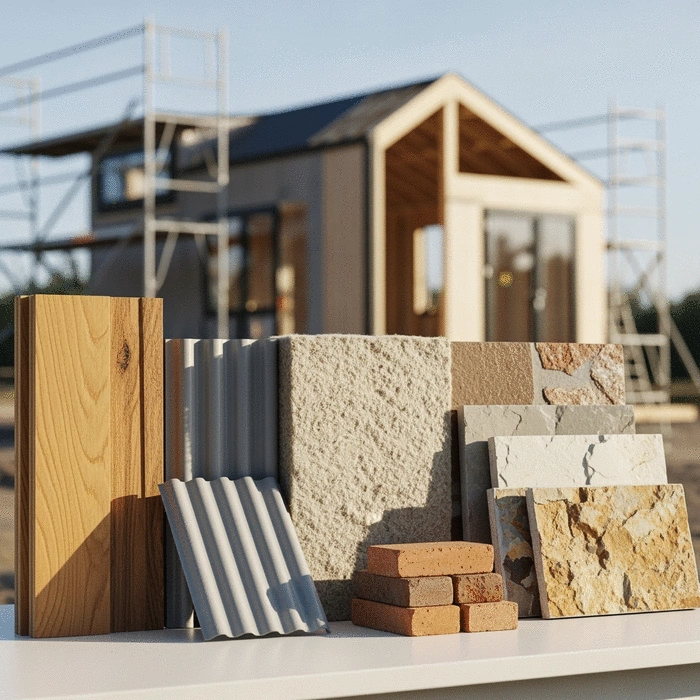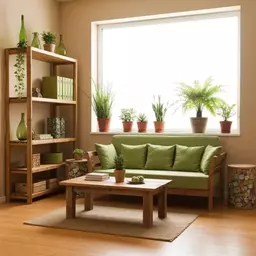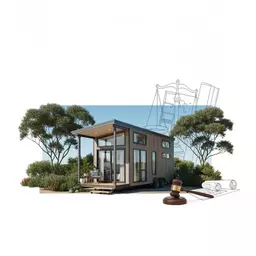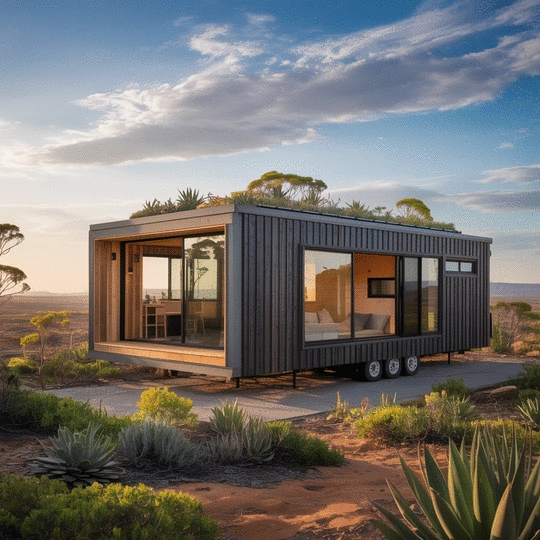Selecting Materials for Tiny Homes

Posted on: 2025-10-24
By: Sophie Marchant
Choosing the right materials for your tiny home isn’t just a matter of aesthetics; it shapes your living experience, impacts the environment, and affects the longevity of your home. With so many options available, understanding the nuances of material selection can empower you to create a sustainable, cost-effective, and comfortable living space.
What You Will Learn
- The significance of material selection in enhancing the durability and energy efficiency of tiny homes.
- Key characteristics of tiny homes that define their unique appeal, including compact design and eco-friendliness.
- How local building codes impact material choices and the importance of compliance to avoid potential legal issues.
- Recommendations for materials based on regional climate conditions to improve the longevity and comfort of your tiny home.
- Common misconceptions about tiny home materials and the best sustainable options available.
- Strategies for engaging with the tiny home community for valuable insights and support during your building journey.
Characteristics and Benefits of Tiny Home Construction
Understanding the key characteristics and benefits of tiny home living can significantly guide material selection and design choices.
Compact Design
Efficient use of space is essential in tiny homes, promoting minimalism and functionality.
Eco-friendly Materials
Utilizing sustainable materials helps reduce environmental impact and enhances energy efficiency.
Mobility
Tiny homes can be designed on trailers for easy transportation, enhancing lifestyle flexibility.
Cost-effective
Lower costs often lead to reduced financial stress, making tiny living appealing.
Reduced Environmental Impact
Smaller homes generally consume fewer resources, promoting sustainability.
Lower Utility Bills
Less space means lower energy costs for heating and cooling, leading to savings.
Understanding the Importance of Material Selection in Tiny Home Construction
When it comes to tiny home construction, choosing the right materials is essential! The materials you select play a crucial role in determining not just the look of your home, but also its durability and energy efficiency. As an advocate for sustainable living, I can’t stress enough how these choices can transform your tiny house into a cozy, eco-friendly sanctuary.
So, what exactly does tiny home construction involve? Tiny homes are generally defined as dwellings that measure less than 400 square feet. They are designed to maximize space while minimizing clutter, hence promoting a more sustainable lifestyle. As you embark on your tiny home journey, understanding the characteristics of these homes will help guide your material choices.
Defining Tiny Home Construction: What You Need to Know
A tiny home is not just about its size; it embodies a lifestyle centered around simplicity and minimalism. These homes often feature open floor plans and multifunctional spaces that allow you to make the most of every inch. Here are some key characteristics of tiny homes:
- Compact design: Efficient use of space is essential.
- Eco-friendly materials: Many tiny homes are built with sustainable materials.
- Mobility: Some tiny homes are designed on trailers for easy transportation.
- Cost-effective: Lower costs often lead to reduced financial stress.
These characteristics not only highlight the appeal of tiny homes but also emphasize the importance of good material selection. By considering your material choices carefully, you can create a space that is not only beautiful but also enhances your overall living experience.
Key Characteristics of Tiny Homes and Their Benefits
Living in a tiny home can lead to a simpler, more fulfilling life. The benefits extend beyond just a cozy living space; they can also include:
- Reduced environmental impact: Smaller homes generally consume fewer resources.
- Lower utility bills: Less space means lower energy costs for heating and cooling.
- Increased mobility: Tiny homes can offer the freedom to travel while still having a personal space.
- Stronger community ties: Many tiny home dwellers form close-knit communities.
As you can see, these advantages make the tiny home lifestyle appealing. However, achieving these benefits largely depends on selecting the right materials that align with your values and goals for sustainable living.
How Material Choices Impact Your Tiny Home’s Longevity and Efficiency
Material choice goes beyond aesthetics. The longevity and efficiency of your tiny home are greatly influenced by what you select. Choosing high-quality materials can save you time and money in the long run, as they will require less maintenance and stand up to the elements more effectively.
When evaluating materials for your tiny home, consider the following aspects:
- Energy efficiency: Insulation and windows should minimize heat loss or gain.
- Durability: Look for materials that can withstand wear, weather, and pests.
- Maintenance: Opt for materials that are easy to care for, thus reducing long-term upkeep.
By making informed decisions about your material selections, you're setting the foundation for a home that not only stands the test of time but also remains energy efficient.
Importance of Durability and Weather Resistance
In building a tiny home, the importance of durability and weather resistance cannot be overstated. Depending on where you live, your tiny home may face various weather conditions, from heavy rains to intense heat. It’s essential to choose materials that can withstand these factors.
Here are some materials often recommended for their durability and resistance:
- Cedar and cypress wood: Both are naturally resistant to decay and insects.
- Metal roofing: A long-lasting option that can handle severe weather conditions.
- High-quality insulation: Ensures your home stays comfortable year-round.
By prioritizing durability in your material choices, you can create a tiny home that is resilient and ready to embrace the elements, which is key to enjoying a sustainable lifestyle. Let’s build a home that truly lasts!
Pro Tip
When selecting materials for your tiny home, consider not only their immediate benefits but also their lifecycle impact. For instance, choosing materials that are locally sourced can significantly reduce your carbon footprint while supporting the local economy. Additionally, look for certifications like FSC (Forest Stewardship Council) for wood products, which ensure that materials are sustainably harvested.
Addressing Regional Considerations in Tiny Home Material Selection
When building a tiny home, considering your region's unique characteristics is essential. Local building codes can significantly influence the materials you choose, impacting everything from safety to aesthetics. As the founder of The Tiny Living Guide, I've seen firsthand how understanding these regulations is crucial for any aspiring tiny home builder.
In different areas, regulations may dictate specific materials for construction, which can affect your budget and overall design. For example, some regions may require fire-resistant materials or specific insulation standards based on climate. It’s always best to check with your local authorities before making material decisions!
How Local Building Codes Influence Material Choices
Local building codes set the groundwork for what’s permissible in construction. These guidelines vary from state to state, impacting everything from structural integrity to energy efficiency standards. Understanding these regulations can save you time, money, and potential headaches down the line.
- Research your local building codes to know which materials are approved.
- Consult with a local builder familiar with tiny homes to navigate the rules.
- Consider materials that comply with energy efficiency standards.
Adapting to Climate: Choosing Materials that Suit Your Environment
The climate in your area plays a significant role in determining suitable materials for your tiny home. For instance, if you live in a region with heavy rainfall, you'll want materials that resist moisture and prevent rot. On the other hand, hot and dry climates may require materials that reflect heat and improve energy efficiency.
- Moisture-resistant materials: Opt for treated wood or metal siding in wet climates.
- Insulation types: Use spray foam or fiberglass in warmer regions to keep your home cool.
- Reflective roofing: A lighter-colored roof can help combat heat in sunny areas.
Common Questions About Tiny Home Materials Answered
It's natural to have questions when it comes to selecting materials for your tiny home. Many potential builders wonder about the best options for durability, cost, and sustainability. I often find that addressing these common concerns can help ease the decision-making process!
FAQs Addressing Key Concerns and Misconceptions
Here are some frequently asked questions to help you in your tiny home material selection:
- What are the most sustainable materials for tiny homes?
Opt for materials like reclaimed wood, bamboo, and recycled metal to make eco-friendly choices. These materials often have a lower environmental impact and can contribute to a healthier indoor environment. - How important is insulation in a tiny home?
Insulation is vital for maintaining comfort and energy efficiency, especially in extreme climates. Good insulation reduces the need for excessive heating or cooling, leading to lower utility bills and a more comfortable living space. - Can I use standard building materials for my tiny home?
While you can, it’s essential to ensure they meet local codes and suit your specific needs for efficiency and durability. Standard materials might be heavier or less efficient for the compact nature of tiny homes. - How do I balance cost and quality when choosing materials?
Balancing cost and quality involves prioritizing key structural and environmental components. Invest in high-quality insulation, roofing, and flooring for longevity, and consider more budget-friendly options for interior finishes that are easier to replace later. - What are the common misconceptions about tiny home materials?
A common misconception is that tiny homes must use only specialized, expensive materials. In reality, many tiny homes utilize readily available, sustainable, and cost-effective materials. Another misconception is that tiny homes are not as durable as traditional homes, which can be disproven by selecting robust, weather-resistant materials.
Reflecting on Cost, Durability, and Eco-Friendliness
In conclusion, selecting the right materials for your tiny home involves weighing various factors like cost, durability, and environmental impact. By considering regional building codes and climate conditions, you can make informed choices that enhance your living experience. Remember, every decision you make brings you one step closer to your dream tiny home!
Encouraging Informed Decision-Making for Future Tiny Home Builders
As you plan your tiny home journey, I encourage you to research and connect with the community. Engage with others who have gone through the process, like those at The Tiny Living Guide, to gain invaluable insights and tips. The more informed you are, the more confident you'll feel in your decisions.
Next Steps: Planning Your Tiny Home Build with Confidence
Take the next step in your tiny home adventure by exploring materials that resonate with your values and lifestyle. Remember, building a tiny home is not just about the physical structure; it’s about creating a space that reflects who you are and your commitment to sustainable living.
Recap of Key Points
Here is a quick recap of the important points discussed in the article:
- Selecting the right materials is crucial for the durability and energy efficiency of tiny homes.
- Tiny homes promote a sustainable lifestyle through compact design and multifunctional spaces.
- Material choices should consider energy efficiency, durability, and maintenance requirements.
- Local building codes and regional climate significantly influence material selection.
- Opt for eco-friendly materials to reduce environmental impact while ensuring longevity.
- Engage with the tiny living community for insights and support in your building journey.
 What if your small living space could also be a sanctuary for the planet? Embracing sustainability n
What if your small living space could also be a sanctuary for the planet? Embracing sustainability n
 As the tiny home movement gains momentum in Australia, the legal landscape can feel daunting. Howeve
As the tiny home movement gains momentum in Australia, the legal landscape can feel daunting. Howeve
 Did you know that zoning laws can significantly impact the feasibility of sustainable housing initia
Did you know that zoning laws can significantly impact the feasibility of sustainable housing initia
